height TOYOTA SEQUOIA 2008 2.G Owners Manual
[x] Cancel search | Manufacturer: TOYOTA, Model Year: 2008, Model line: SEQUOIA, Model: TOYOTA SEQUOIA 2008 2.GPages: 596, PDF Size: 12.93 MB
Page 20 of 596
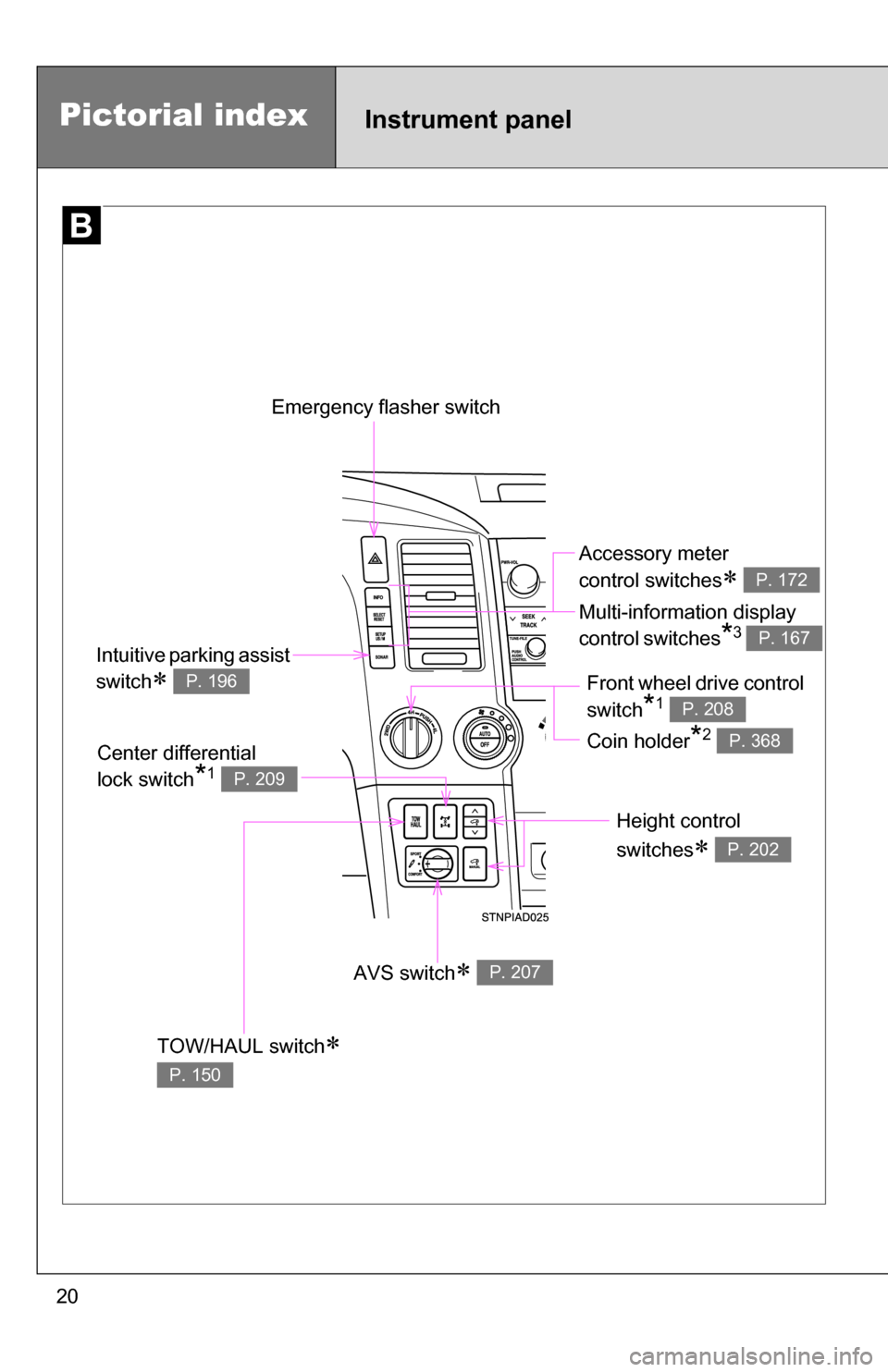
20
Pictorial indexInstrument panel
Emergency flasher switch
TOW/HAUL switch
P. 150
Height control
switches
P. 202
AVS switch P. 207
Center differential
lock switch
*1 P. 209
Accessory meter
control switches
Multi-information display
control switches
*3
P. 172
P. 167Intuitive parking assist
switch
P. 196Front wheel drive control
switch
*1
Coin holder
*2
P. 208
P. 368
Page 46 of 596
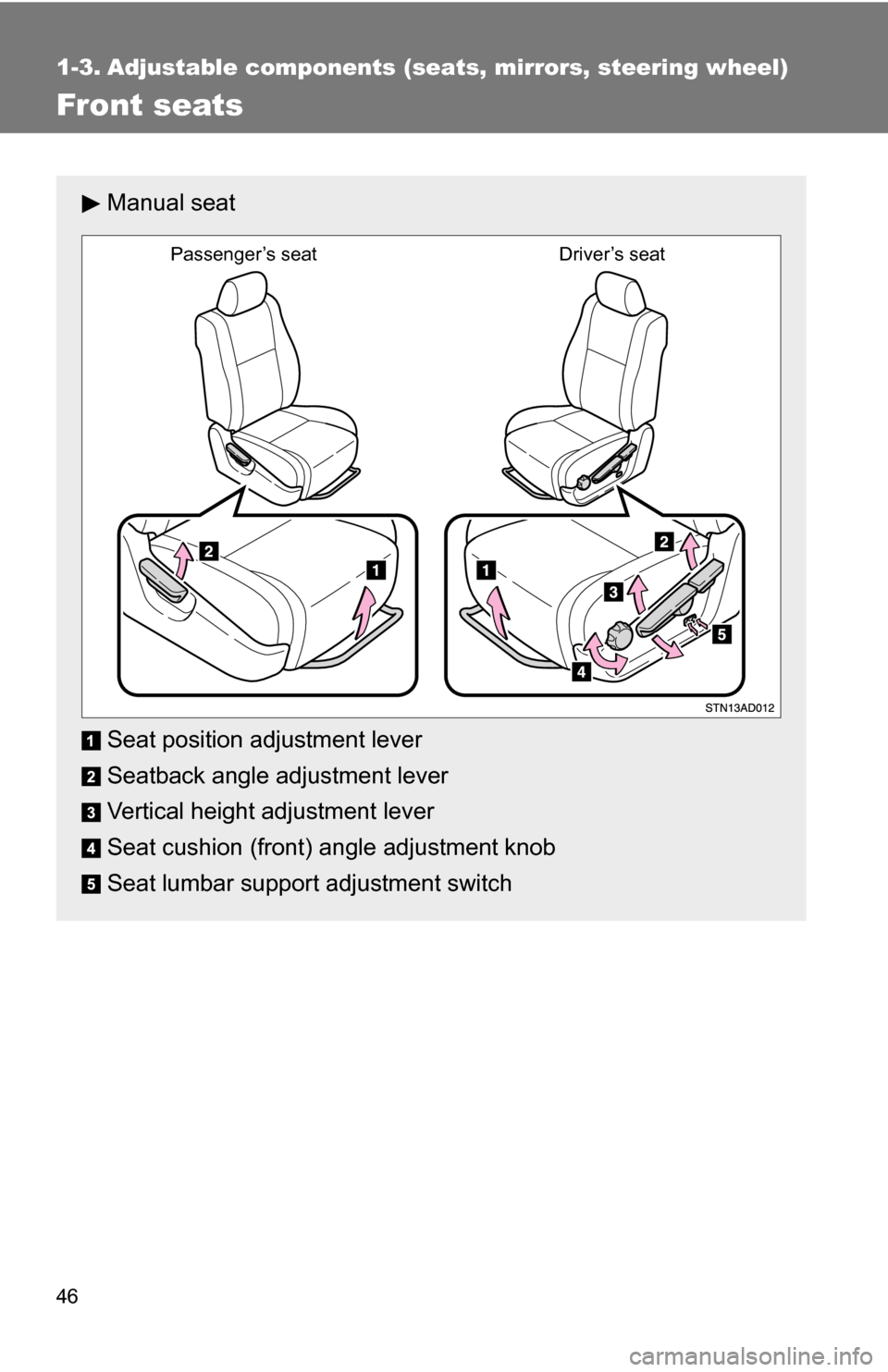
46
1-3. Adjustable components (seats, mirrors, steering wheel)
Front seats
Manual seat
Seat position adjustment lever
Seatback angle adjustment lever
Vertical height adjustment lever
Seat cushion (front) angle adjustment knob
Seat lumbar support adjustment switch
Passenger’s seat Driver’s seat
Page 47 of 596

47
1-3. Adjustable components (s
eats, mirrors, steering wheel)
1
Before driving
Power seat
Seat position adjustment switch
Seatback angle adjustment switch
Seat cushion (front) angle adjustment switch
Vertical height adjustment switch
Driver’s seat leg support adjustment switch (if equipped)
Seat lumbar support adjustment switch
Passenger’s seat Driver’s seat
Page 63 of 596

63
1-3. Adjustable components (s
eats, mirrors, steering wheel)
1
Before driving
■Adjusting the height of the head restraints
■ Adjusting the center r ear seat head restraint
Always raise the head restraint one level from the stowed position when
using.
CAUTION
■ Head restraint precautions
Observe the following precautions regarding the head restraints. Failure to
do so may result in death or serious injury.
●Use the head restraints designed for each respective seat.
● Adjust the head restraints to the correct position at all times.
● Do not drive with the head restraints removed.
Make sure that the head restraints are
adjusted so that the center of the head
restraint is closest to the top of your ears.
Page 65 of 596

65
1-3. Adjustable components (s
eats, mirrors, steering wheel)
1
Before driving
Releasing the belt
Press the release button.
■Adjusting the height of the belt
Down
Up
Move the height adjuster up
and down as needed until you
hear a click.
Page 140 of 596
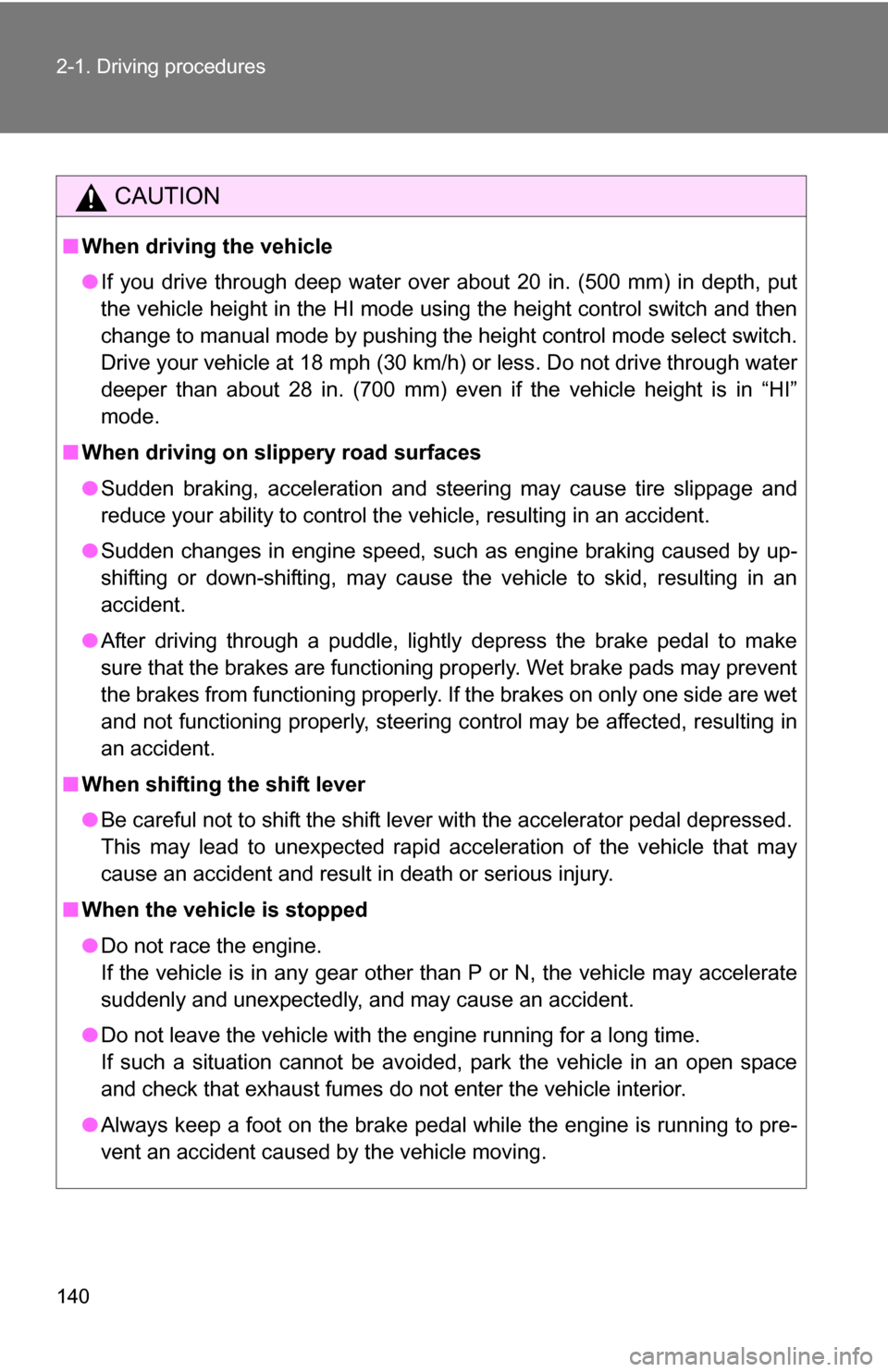
140 2-1. Driving procedures
CAUTION
■When driving the vehicle
●If you drive through deep water over about 20 in. (500 mm) in depth, put
the vehicle height in the HI mode using the height control switch and then
change to manual mode by pushing the height control mode select switch.
Drive your vehicle at 18 mph (30 km/h) or less. Do not drive through water
deeper than about 28 in. (700 mm) even if the vehicle height is in “HI”
mode.
■ When driving on slippery road surfaces
●Sudden braking, acceleration and steering may cause tire slippage and
reduce your ability to control the vehicle, resulting in an accident.
● Sudden changes in engine speed, such as engine braking caused by up-
shifting or down-shifting, may cause the vehicle to skid, resulting in an
accident.
● After driving through a puddle, lightly depress the brake pedal to make
sure that the brakes are functioning properly. Wet brake pads may prevent
the brakes from functioning properly. If the brakes on only one side are wet
and not functioning properly, steering control may be affected, resulting in
an accident.
■ When shifting the shift lever
●Be careful not to shift the shift lever with the accelerator pedal depressed.
This may lead to unexpected rapid acceleration of the vehicle that may
cause an accident and result in death or serious injury.
■ When the vehicle is stopped
●Do not race the engine.
If the vehicle is in any gear other than P or N, the vehicle may accelerate
suddenly and unexpectedly, and may cause an accident.
● Do not leave the vehicle with the engine running for a long time.
If such a situation cannot be avoided, park the vehicle in an open space
and check that exhaust fumes do not enter the vehicle interior.
● Always keep a foot on the brake pedal while the engine is running to pre-
vent an accident caused by the vehicle moving.
Page 164 of 596

164 2-2. Instrument cluster
■Indicators
The indicators inform the driver of the operating state of the
vehicle’s various systems.
Turn signal indicator
(P. 155)*AUTO LSD indicator
( P. 212, 215)
Headlight high beam
indicator ( P. 175)
(4WD models)
Center differential lock
indicator ( P. 209)
Security indicator
(P. 96)RSCA OFF indicator
( P. 115)
Shift position and shift
range indicators
(P. 148, 152)
*AIR BAG ON indicator
( P. 116)
*AIR BAG OFF indicator
(P. 116)
(4WD models)
4HI indicator ( P. 208)
Cruise control indicator
(P. 183, 186)
(4WD models)
4LO indicator ( P. 208)
*Slip indicator
( P. 212, 214)
(If equipped)
TOW HAUL indicator
( P. 150)
*VSC OFF indicator
(P. 212, 215, 216)*Height control HI indica-
tor (P. 202)
(U.S.A.)
Headlight indicator
(P. 175)*Height control N indica-
tor (P. 202)
(Canada)
Tail light indicator
(P. 175)*Height control LO indi-
cator (P. 202)
Page 165 of 596

165
2-2. Instrument cluster
2
When driving
■
Warning lights
Warning lights inform the driver of malfunctions in any of the
vehicle’s systems. ( P. 505)
*: These lights turn on when the engine switch is turned to the ON
position to indicate that a system check is being performed. They will
turn off after the engine is started, or after a few seconds. There may
be a malfunction in a system if a light does not come on, or if the
lights do not turn off. Have the vehicle inspected by your Toyota
dealer for details.
1:Vehicles with multi-information display
2:Vehicles without multi-information display
*Height control MAN.
indicator ( P. 203)
(Canada)(U.S.A.)(Canada)(U.S.A.)
(U.S.A.)
1*******
*22**
Page 202 of 596
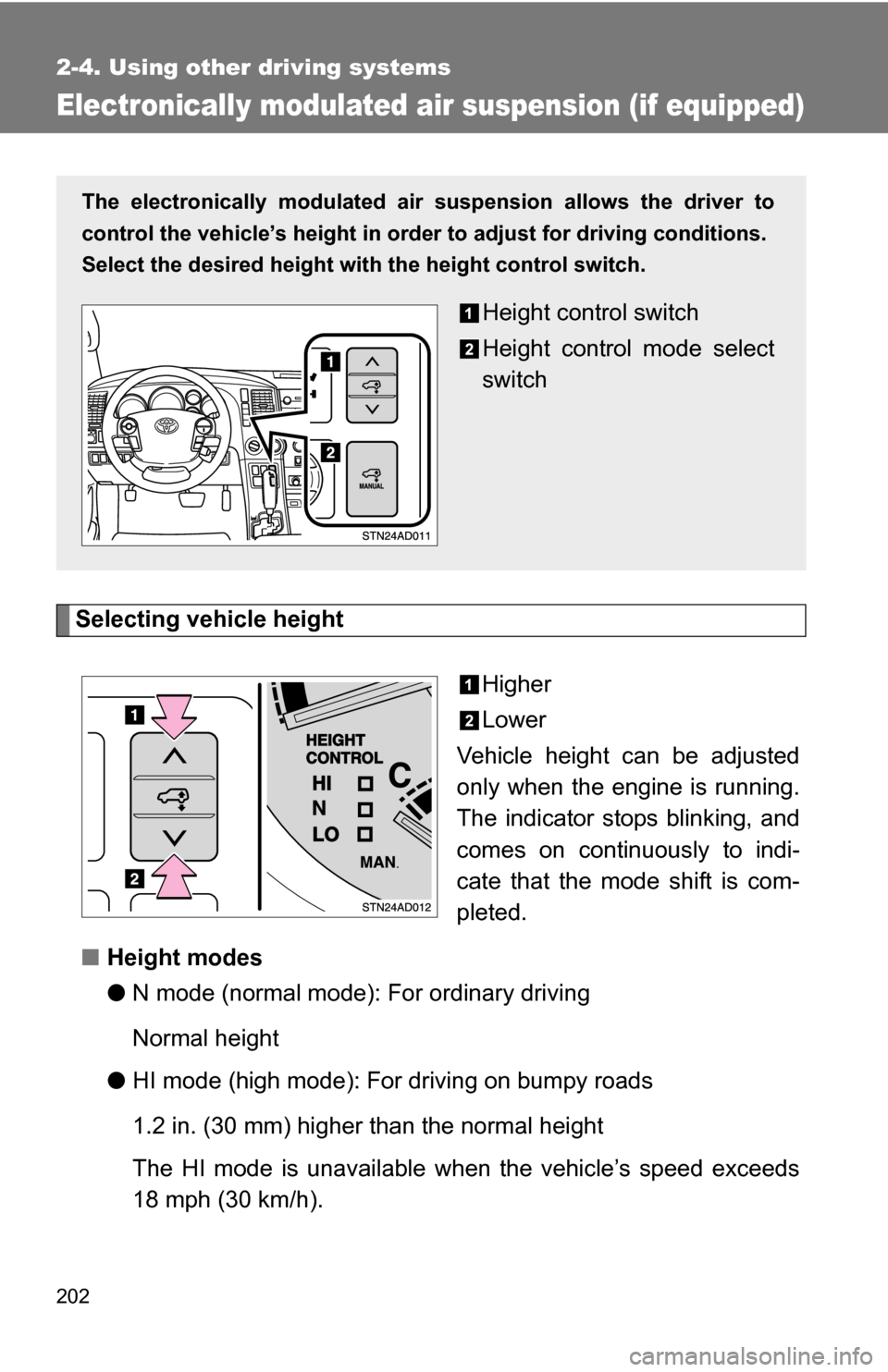
202
2-4. Using other driving systems
Electronically modulated air suspension (if equipped)
Selecting vehicle heightHigher
Lower
Vehicle height can be adjusted
only when the engine is running.
The indicator stops blinking, and
comes on continuously to indi-
cate that the mode shift is com-
pleted.
■ Height modes
●N mode (normal mode): For ordinary driving
Normal height
● HI mode (high mode): For driving on bumpy roads
1.2 in. (30 mm) higher than the normal height
The HI mode is unavailable w hen the vehicle’s speed exceeds
18 mph (30 km/h).
The electronically modulated air suspension allows the driver to
control the vehicle’s height in orde r to adjust for driving conditions.
Select the desired height with the height control switch.
Height control switch
Height control mode select
switch
Page 203 of 596
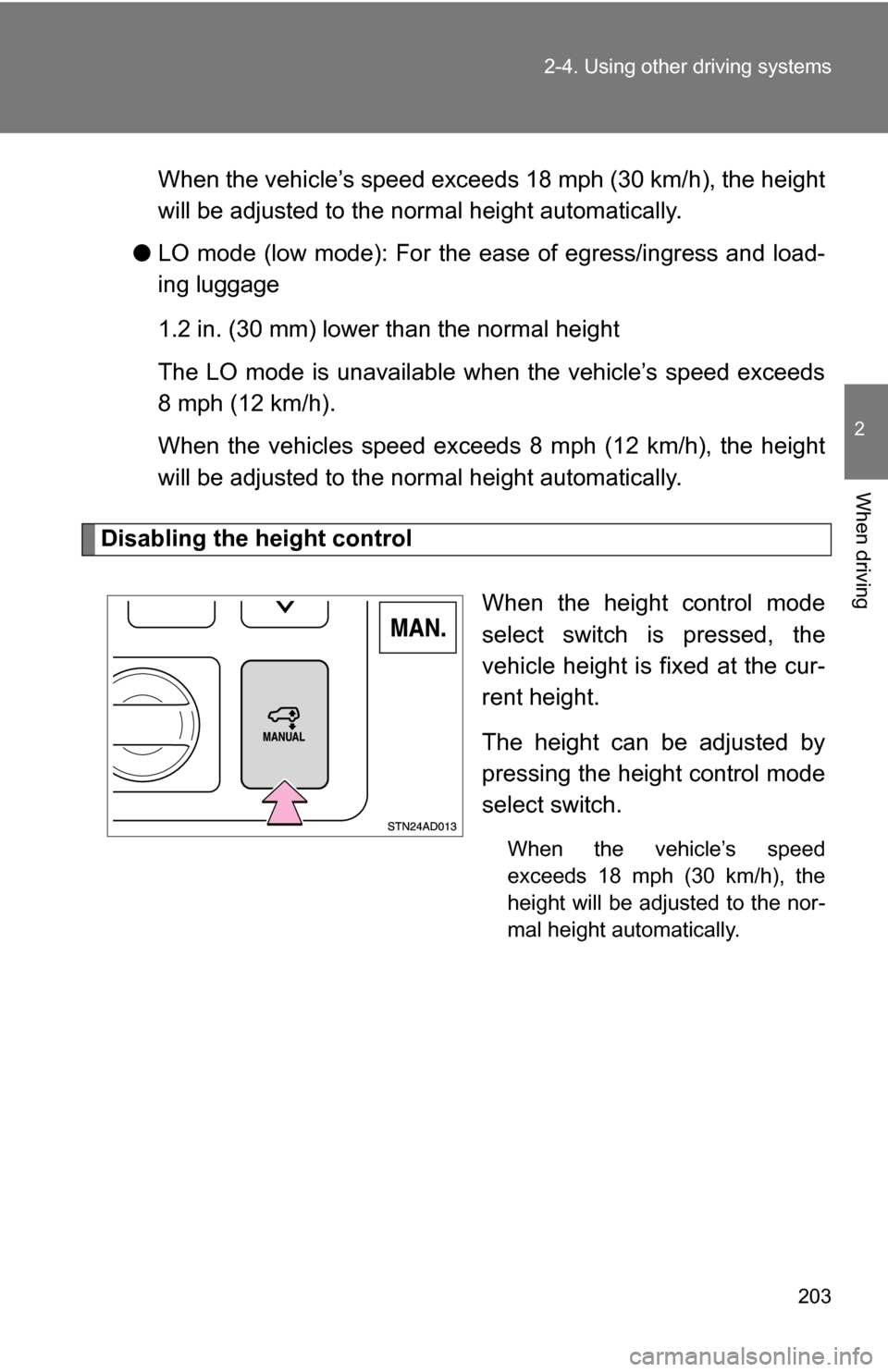
203
2-4. Using other
driving systems
2
When driving
When the vehicle’s speed exceed s 18 mph (30 km/h), the height
will be adjusted to the norm al height automatically.
● LO mode (low mode): For the ease of egress/ingress and load-
ing luggage
1.2 in. (30 mm) lower than the normal height
The LO mode is unavailable when the vehicle’s speed exceeds
8 mph (12 km/h).
When the vehicles speed exceeds 8 mph (12 km/h), the height
will be adjusted to the norm al height automatically.
Disabling the height control
When the height control mode
select switch is pressed, the
vehicle height is fixed at the cur-
rent height.
The height can be adjusted by
pressing the height control mode
select switch.
When the vehicle’s speed
exceeds 18 mph (30 km/h), the
height will be adjusted to the nor-
mal height automatically.